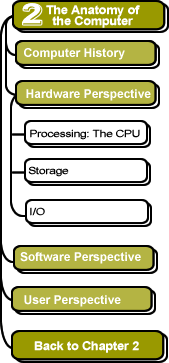

|
Input/Output (I/O)
|
Computer hardware includes three main subsystems:
|
On two occasions I have been asked (by members of Parliament!), 'Pray, Mr. Babbage, if you put into the machine wrong figures, will the right answers come out?' I am not able rightly to apprehend the kind of confusion of ideas that could provoke such a question. Charles
Babbage |
The Input/Output (I/O) system moves information in and out of the computer.
While the CPU is the "brains" of the computer, the I/O system could be considered the senses. It provides the means for the CPU to communicate with the user and the outside world, to "see" and to "hear." The I/O system consists of a variety of I/O devices (such as keyboards and monitors) and the informational infrastructure needed for the CPU to control and communicate with each of the devices. The I/O system moves information back and forth between the CPU and the I/O devices (sometimes called peripherals).
Basic questions about I/O
- What are some examples of I/O devices?
- What is the difference
between interrupt-driven I/O versus polling I/O?
![]()
![]()
These pages were written by Steven H. VanderLeest and Jeffrey Nyhoff and edited by Nancy Zylstra
©2005 Calvin University (formerly Calvin College), All Rights Reserved
If you encounter technical errors, contact computing@calvin.edu.